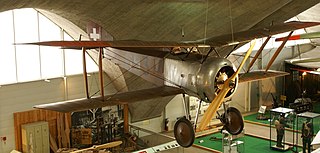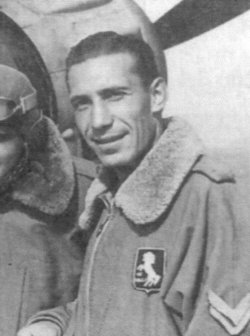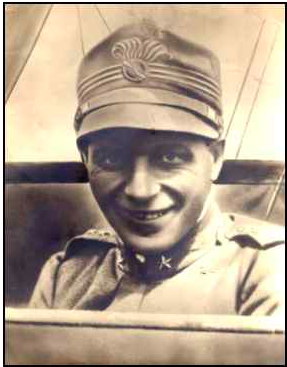
Aermacchi was an Italian aircraft manufacturer. Formerly known as Aeronautica Macchi, the company was founded in 1912 by Giulio Macchi at Varese in north-western Lombardy as Nieuport-Macchi, to build Nieuport monoplanes under licence for the Italian military. With a factory located on the shores of Lake Varese, the firm originally manufactured a series of Nieuport designs, as well as seaplanes.

The Nieuport 11, nicknamed the Bébé, is a French World War I single seat sesquiplane fighter aircraft, designed by Gustave Delage. It was the primary aircraft that ended the Fokker Scourge in 1916. The type saw service with several of France's allies, and gave rise to the series of "vee-strut" Nieuport fighters that remained in service into the 1920s.

The Nieuport 27 was a World War I French sesquiplane fighter aircraft designed by Gustave Delage. The 27 was the last of the line of Nieuport "V-strut" single seat fighters that began with the Nieuport 10 of 1914. Operational examples supplemented the very similar Nieuport 24 and 24bis in operational squadrons in late 1917 and many would also be used as advanced trainers.

The Nieuport 10 is a French First World War sesquiplane that filled a wide variety of roles, including reconnaissance, fighter and trainer.

The Hanriot HD.1 is a French World War I single-seat fighter aircraft. Rejected for service with French squadrons in favour of the SPAD S.VII, the type was supplied to the Aviation Militaire Belge and the Corpo Aeronautico Militare of the Royal Italian Army, with both of which it proved highly successful. Of a total of about 1,200 examples built, 831 were produced by Italian companies under licence.

The Italian Corpo Aeronautico Militare was formed as part of the Regio Esercito on 7 January 1915, incorporating the Aviators Flights Battalion (airplanes), the Specialists Battalion (airships) and the Ballonists Battalion. Prior to World War I, Italy had pioneered military aviation in the Italo-Turkish War during 1911–1912. Its army also contained one of the world's foremost theorists about the future of military aviation, Giulio Douhet; Douhet also had a practical side, as he was largely responsible for the development of Italy's Caproni bombers starting in 1913. Italy also had the advantage of a delayed entry into World War I, not starting the fight until 24 May 1915, but took no advantage of it so far as aviation was concerned.

Tenente Silvio Scaroni was an Italian World War I fighter pilot credited with 26 victories. He was the second ranking Italian ace of the war.

Leonardo Ferrulli was an ace of the Regia Aeronautica, and a recipient of the Medaglia d'Oro al Valor Militare. He was credited with 22 air victories, one during the Spanish Civil War and 21 during World War II. He shot down Hurricanes, P-40s, P-38 Lightnings, Spitfires and B-17s, flying Fiat C.R.42 biplanes and Macchi C.200/202 monoplanes. His unit was 91a Squadriglia, 10° Gruppo, from 4° Stormo, one of the top-scoring fighter units of Regia Aeronautica.

78a Squadriglia was one of the original Italian fighter squadrons of World War I, serving in combat from 29 June 1916 to 3 November 1918. They flew 4,770 combat missions and were credited with 88 aerial victories.

Teresio Vittorio Martinoli, MOVM, was an Italian World War II fighter pilot in the Regia Aeronautica and in the Italian Co-Belligerent Air Force (ICBAF). During the war, he fought over Libya and Tunisia, in North Africa, on Malta, and was involved in the defence of the Italian mainland. Martinoli has been credited with 22 air victories and 14 shared destroyed in 276 sorties. Flying the Fiat C.R.42 biplane and Macchi C.202 and C.205 monoplanes, he shot down: a Gloster Gladiator, Bristol Blenheims, Hawker Hurricanes, Curtiss P-40s, Spitfires, a P-38 Lightning, a Boeing B-17 Flying Fortress, and a Junkers Ju 52, the last after the Armistice of Cassibile.
Mario Aramu was an Italian aviator.

The Caproni Ca.22 was a single-engine monoplane made by the Italian company Aeronautica Caproni in 1913.

Guido Keller was an Italian aviator and political activist who was closely associated with Gabriele D’Annunzio and played an important role in the seizure of Fiume in 1919.
Alessandro Tonini was an important Italian aeronautical engineer and aircraft designer of the early 20th century who worked for Gabardini, Macchi, and IMAM.
Giovanni De Briganti was an Italian World War I fighter pilot, seaplane air racer of the 1920s, aerobatic pilot, and test pilot.

Mario Ajmone Cat was an Italian Air Force general during World War II. He was Chief of Staff of the Italian Air Force from 1944 to 1951.

Vincenzo Velardi was an Italian Air Force general during the Spanish Civil War, in which he commanded the Aviazione Legionaria, and World War II.

Mario Ugo Gordesco was an Italian captain and aviator of the Regia Aeronautica during World War I. He is considered to be a pioneer within Italian aviation and was a major figure within the early Regia Aeronautica.

Egidio Grego was an Italian soldier and aviator who was awarded four medals for military valor, two of which were Silver Medal of Military Valor.

The Air Battle on Istrana was an air battle that took place in the sky over the town of Istrana on 26 December 1917, as part of the First World War. It was the most important air battle on the Italian front.
















